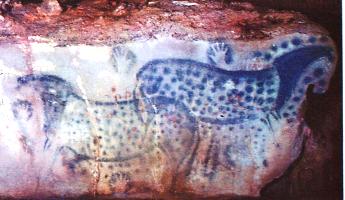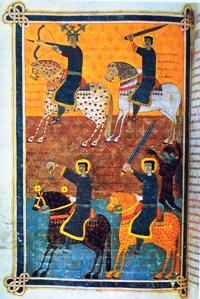
THE STUD AT LIPIZZANO by Johann Georg Hamilton.This group of brood mares, painted in 1727, shows the great number of coat colors prevalent amoung the original Lippizaner stock–palomino, tobiano, and a well marked blanketed Appaloosa. Courtesy of Colonel Alois Podhajsky, Commandant, Spanische Reitschule, Vienna, Austria.
Through the centuries spotted horses have been given names ranging from the mystical Celestial Horses in China, to the Knabstrupper in Denmark, to the Tigre in France.
The name Appaloosa joins in this history around the late 1800s. It was during this time that the term Appaloosa was first used to describe the spotted horses of the Palouse region. The Palouse, or Palouse Country, is the area of Washington and Idaho drained by the Palouse River. Early white settlers referred to the spotted horse of the area as a Palouse horse. Over time the a and Palouse were slurred together to first form the name Apalousey and later Appaloosa. The word Palouse most probably has its origin in the Sehaptin language spoken by the Nez Perce and Palouse Indians. It means “something sticking down in the water” in reference to a large rock at the confluence of the Snake and Palouse Rivers where the main village of the Palouse or Palus Indians was built. (1)

Prehistoric Man and Horses
One of the facinating aspects of history is that the more we study the more we learn. It used to be assumed that the first evidence of the spotted horse was found in cave paintings dating from around 18,000 BC at Lascaux and Peche -Merle in France.
Anthropologists hypothetized that these horses may be the remote ancestors of present day spotted horses.Spotted horses can be seen in art across the globe.
Ferghana Valley (present day Uzbekistan)
The Bronze Age (roughly 1750 – 1500 BC) ushered in the use of the horse drawn chariot. Commerce and travel along the Silk Road of 100 BC to 200 CE widened interaction and connection across the Asiatic Steppes. The area of Fergana in the heart of the Asiatic Steppes appears to be a main source from which horses of superior size, strength, speed and intelligence emerged.
China
Around 100 BC the Emperor Wu Ti sent court officials to Ferghana to obtain these superior horses who they called Heavenly or Celestial horses. Some thought that they were those prophesized in the Book of Changes as “the heavenly horses will come from the northwest.” The spotted horse continues to be profusely depicted in Chinese art.

Persia (present day Iran)
Persians claim the ancestor of all spotted horses to be Rakush, the spotted warhorse of the hero Rustam who lived approximately 400 BC.
Rakush was said to be sired by a white demon, a symbol of good. The exploits of Rakush and Rustam are detailed in the 11th century epic Shah Nameh of Firdausi.
Ancient Mediterranean World
 Scattered evidence of the spotted horse shows up throughout the ancient Mediterranean world.
Scattered evidence of the spotted horse shows up throughout the ancient Mediterranean world.
This vase, found near the Tombs of Aegisthus and Clytemnestra outside the citadel at Mycenae (Greece) is dated ca. 1300 BC. It is decorated with warriors in a horse drawn chariot.
Austria (Lead Image Above)
The earliest evidence of the spotted horse in Austria was a sword found at a graveyard in Hallstatt , Austria, dated around 800 BC. The sword was encased in an iron scabbard decorated with an engraving of four men riding horses with spots on their rumps.
In the mid-16th century, Austria acquired a group of Andalusian horses from Spain. First put on a breeding farm in Kladrub, Bohemia, most of the horses soon moved to Equile Lipizzano. Called Lipizzans, these horses were raised for the Austrian royal family.
Those that showed unusual ability and intelligence were given special training. Because the Lipizzan horses originally came from Spanish stock, their training center was called the Spanish Riding School. Those horses that stayed in Kladrub were bred to become carriage horses called Pinzgau.
* Detail of THE STUD AT LIPIZZANO by Johann Georg Hamilton. This group of brood mares, painted in 1727, shows the great number of coat colors prevalent amoung the original Lippizaner stock–palomino, tobiano, and a well marked blanketed Appaloosa. Courtesy of Colonel Alois Podhajsky, Commandant, Spanische Reitschule, Vienna, Austria.
France
The first evidence of spotted horses in France was found in the 11th century.
Artwork with spotted horses often depicted the horses carrying nobles, kings , or saints. In the 17th century Louis XIV and Louis XV both demanded to portrayed in paintings and tapestries on spotted horses. Louis XVI had a driving team of two spotted horses. In France the spotted horse was called Tigre.
Denmark
Spotted horses made their way north into Denmark , Norway and Sweden. Numerous examples of artwork showing spotted horses exist in each country. In the 17th century, Denmark received spotted horses from Austria. But, for some reason the Danish had trouble keeping the correct color and conformation in their breeding so the numbers of spotted horses declined rapidly. Then, in 1808 a Danish butcher bought a spotted mare, the famous Flaebe mare. The offspring of this single mare started the famous line Knabstrupper.

England
Spotted horses begin to appear in English art around the 12th century and much like in France these horses were usually carrying saints or nobles.
* Lady Conway’s Spanish Jennet painted in the 18th century by John Wooton.
The New World
 The Spanish introduced horses to North America in the 16th century. Spanish settlers moved north to the Rio Grande Valley and raised livestock. Though only the Spanish rode horses for herding, travel, and pleasure, it seems inevitable that some of the Indian stable boys did learn to ride.
The Spanish introduced horses to North America in the 16th century. Spanish settlers moved north to the Rio Grande Valley and raised livestock. Though only the Spanish rode horses for herding, travel, and pleasure, it seems inevitable that some of the Indian stable boys did learn to ride.
This illustration is from a miniature of the Commentary of Saint Beatus de Liebana written around 776 on the Apocalypse of St. John , a favorite work of Spanish scribes of the late 9th to 12th centuries. Courtesy of the British Museum, London.
Pueblo Indian Revolt
During 1680 the Pueblo Indian slaves revolted and drove the Spanish from northern New Mexico. The Pueblos kept the sheep and cattle, while they traded of the horses to the Plains Tribes. Through trade and theft horses made their way east and north. By the early 1700s the Plateau tribes had acquired horses.
For the rest of the story click on The History of the ApHC.
Sprague, Roderick. “The Meaning of “Palouse”, Idaho Yesterdays, Summer Issue, 1968: Volume 12, Number 2. Haines, Frances. Appaloosa: The Spotted Horse in Art and History, Austin, TX: University of Texas Press, 1963. Cheryl Wilfong. Following the Nez Perce Trail, Corvallis, OR: Oregon State University Press, 1990.